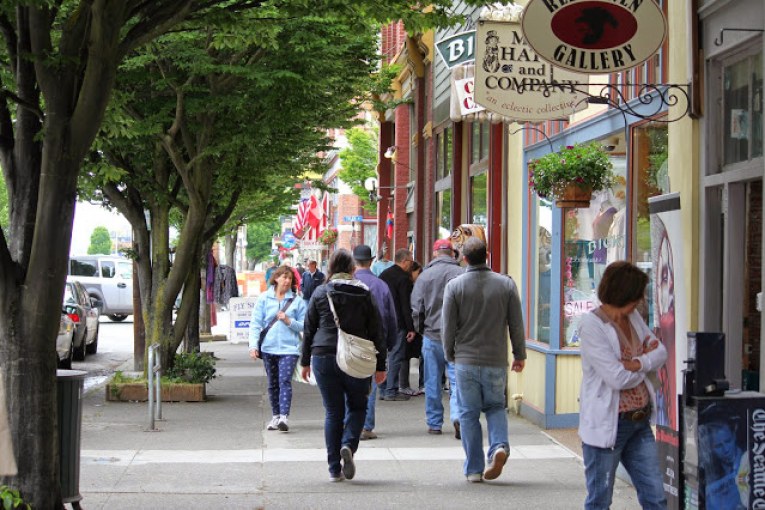
By Dan Zack
The city of Davis is about to embark on redoing its downtown plan and revitalizing retailing. City Planner Dan Zack will share his experience at 7pm at City Council Chambers. This is a preview of some of his wide ranging thoughts. While seats for Thursday event will likely be available, it is suggested RSVP in advance at DFF-VisiontoBricks.Eventbrite.com For more ideas on downtown redevelopment, go to Zack’s blog at plannerdan.com
 |
| Historic mixed use buildings with ground floor retail in Port Townsend, Washington. |
Mixed use downtowns were the hearts of our cities for centuries. Early 20th century reformers, emboldened by their successes in zoning dirty industrial uses away from residential areas, decided that commerce was also an unhealthful influence on neighborhoods and began to outlaw the mixing of uses in early zoning ordinances. As the auto age ramped up, commerce often came hand-in-hand cars and traffic, so the urge to separate retail from homes grew stronger. The mixing of retail and residential uses was prohibited in most urban areas for a long time, and it was one of the factors in the long decline of American downtowns.
Jane Jacobs broke with the conventional wisdom and advocated for mixed uses in the 1960s, but it took planners a while to listen. By the 1990s and 2000s urban revitalization professionals realized that mixed use development was something to be embraced. They saw that vibrant downtowns and urban neighborhoods had mixed uses, and that the most fun, active streets were the ones that had shops on the ground floors. Unfortunately, some cities went overboard and required ground floor retail everywhere. Many of the mandated retail spaces sat vacant, because the population of the area just couldn’t support them.
We need a sensible approach to mixed use that reflects realities and limitations of retail, while also maintaining a commitment to vibrant street life. To be successful we need to redefine retail and deploy it in a very strategic way.
STEP 1: REDEFINE RETAIL
A colleague of mine recently pointed out that every project rendering seems to show an Old Navy in it. We are obsessed with getting mall-style retail into our downtowns, and we need to get over it. Successful downtowns aren’t always going to be places where you can do back to school shopping. It’s great when it happens, but it is difficult and rare. Generally, America is over-retailed, and online shopping is shrinking the need for brick-and-mortar shops.
Dining, entertainment, and personal services are areas in which downtowns and other walkable urban neighborhoods can thrive, and malls and the internet typically cannot. We need to expand our definition of retail to include restaurants, bars, coffee houses, nightclubs, salons, theaters, live music venues, and similar uses. The focus should be on businesses that generate and benefit from high levels of foot traffic throughout the day and week. Until somebody comes up with something catchier, I suggest that we call this expanded concept Retail+.
 |
| This is the dream, apparently. (Photo source: ucr.com) |
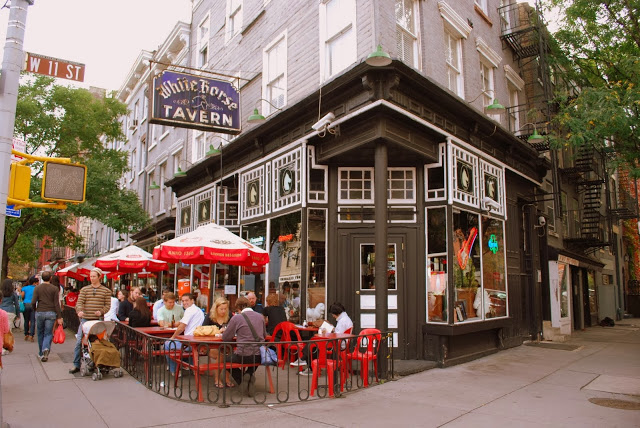 |
| I think this is pretty good, too. |
STEP 2: SITE RETAIL STRATEGICALLY
When creating zoning codes for downtowns and walkable neighborhoods, we need to think like mall designers and retailers. We need to pull people through areas strategically based on the science of what motivates people to walk into some shops and not others. Overall, our focus should be on lining sidewalks with active ground floor uses and avoiding dead blank walls.
Here is my suggestion for how planners should code for retail. After struggling for years with ground floor vacancies in Downtown Redwood City, we finally settled on a strategy similar to this, and it worked. We need to think of ground floor uses in terms of three distinct zones:
High Activity Zone: Retail+ uses need to be clustered together in the most visible, accessible, central, and dense part of the neighborhood, which is where they can be most successful. We need to engineer the hustle and bustle that retail+ thrives on and that people love to see on their main streets.
- Traditionally, retail clustered on the busiest streets, because that’s where the customers were. I think that’s where we need to put it today, too. Unless a retail area is already well-established on a side street, focus your efforts on major streets where the most paths cross. These are areas of pooled use as Jane Jacobs called them, and it is where retail+ will generally be most successful.
- Permitted Ground Floor Uses.Retail+ uses as described above are the only uses that should be allowed on the ground floor in the High Activity Zone. The only exception should be lobbies for upstairs offices, apartments, and hotel rooms. I don’t typically like to regulate land use too tightly, but allowing other uses to intrude into this zone will diminish its success.
- The size of this zone should be based on the existing and planned population of the area, their disposable income, and how much retail+ they can reasonably be expected to support. In most cases, this will probably only be one street, and it probably won’t run for longer than 3 or 4 blocks. If it isn’t clear what the right size is, then error on the side of being too small. If your little retail area is bursting at the seams in a few years, then you can expand it. That is much better than letting shops bleed out everywhere and never getting the critical mass that you need for success. There are recommendations on how much retail space a given number of people can support available from the International Council of Shopping Centers and consultants such as Robert Gibbs. Some of this research is based on suburban situations, but it is still helpful.
- Design Considerations.Your retail+ businesses only need to be 20 to 50 feet deep to get the sidewalk hopping, and I wouldn’t recommend mandating it for the entire depth of the lots and blocks. Non-retail+ uses such as parking, apartments, and offices can be located behind shallow retail+ uses if they don’t need the space. Entrance frequency is important, though (more on that later). Try to make sure you have an entrance into a business every 25 to 35 feet along the sidewalk at the most. If you have a big use, such as a department store or a cinema, then set it back a bit and wrap it with liner shops so that your entrance frequency doesn’t get too low.
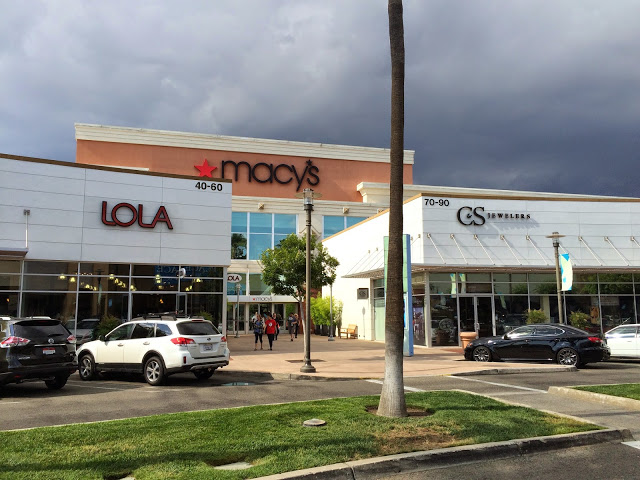 |
| This large Macy’s is wrapped with small liner shops along a shopping street in the River Park lifestyle center in Fresno. |
 |
| This is an old trick, and the liner shops in Fresno’s Warnor’s Theater (1928) attest to that. |
Moderate Activity Zone: Too many urban streets are lined with dead blank walls. These repel pedestrians, hurt property values, and decrease safety. While we can’t support retail everywhere, that doesn’t mean that other areas can be allowed to be lifeless. We still need active frontages in these areas that put eyes on the street, than pull pedestrians through the block, and that generate coming and going activity at the sidewalk.
- This should be the treatment for everything outside of the heart of the neighborhood.
- Permitted Ground Floor Uses.Active non-retail uses should be the only uses permitted on the ground floor in the Moderate Activity Zone. Apartments and offices should be the primary ground floor uses. Live/work units are also fantastic active non-retail uses and should be encouraged. Some small neighborhood serving retail can fit into these areas, but they should be limited to corners, and should be very small, perhaps under 1,000 square feet. A little deli that serves people living upstairs or a laundromat can be fine, but anything significant, especially if it will draw people from outside of the neighborhood, needs to be confined to the High Activity Zone. Retail+ uses can’t be allowed to leak into this area, or you’ll never establish a vibrant retail+ scene in the core of the district.
- Design Considerations.Ground floor apartments should each have their own entrance to the street, which should be accessed via a stoop and/or porch frontage. Ground floor residential doesn’t necessarily need to be set back from the sidewalk, but it should be elevated by a few feet to provide some privacy. Ground floor offices should have storefronts which resemble retail storefronts. Live/work units should typically be accessed by storefronts, although I have seen some cool ones accessed by stoops. It is still ideal to have an entrance into a business or apartment every 25 to 35 feet.
 |
| Don’t do this. Anywhere. Ever. |
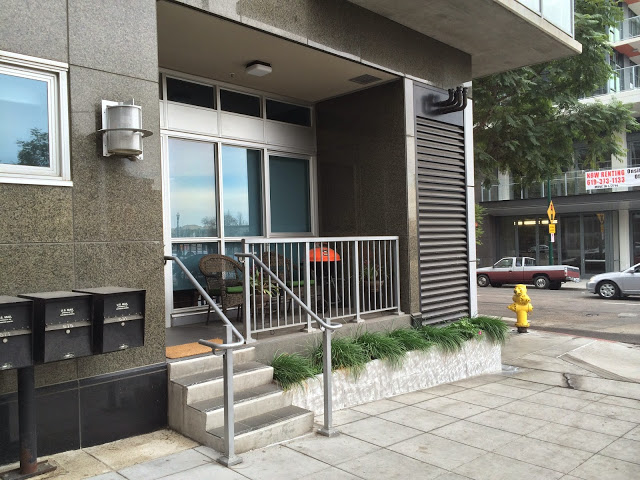 |
| Ground floor apartment with stoop and porch in San Diego. This is a great active non-retail use. |
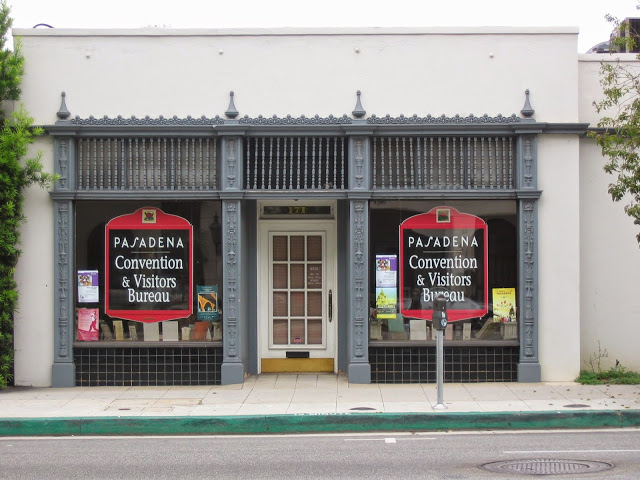 |
| Storefront office in Pasadena. Another good active non-retail use. |
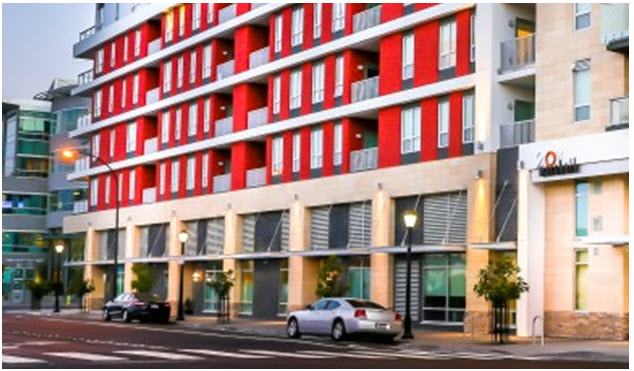 |
| Ground floor live/work units with storefronts in Redwood City. (Photo Source: Raintree Partners) |
Flexible Zone: Here we can allow the market to experiment a bit. Retail+ and other uses can be allowed to mix in this zone, and as the heart of the neighborhood gets going, this flexible zone is the ideal place for retail+ to expand into.
- The Flexible Zone should only extend a half a block or a block outside of the High Activity Zone.
- Permitted Ground Floor Uses.Retail+ and active non-retail uses are both fine in the Flexible Zone.
- Design Considerations.The design parameters for frontages and entrance frequency in the other zones apply here, too.
Now, here’s a look at how the three zones might look in a hypothetical downtown:
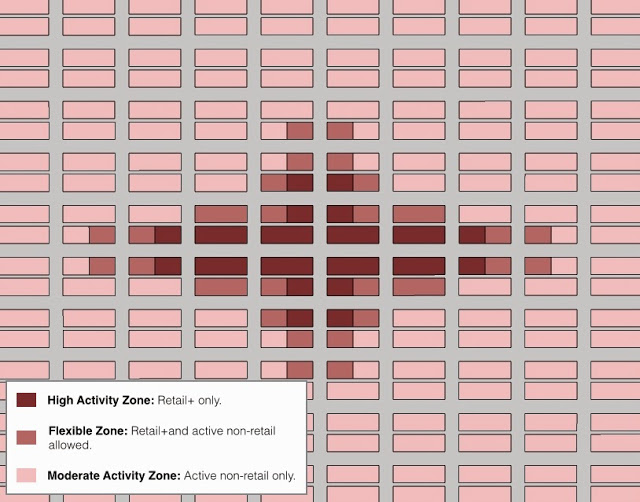
A High Activity Zone should serve a walkable ped shed with a 1/4 to 1/2 mile radius. If your downtown or other urban district is larger than that, you should have a series of High Activity Zones spaced 1/2 to 1 mile apart, each of which serve the surrounding area that is within a 5 to 10 minute walk.
I’ll wrap up this post with some thoughts about entrance frequency. It is sometimes difficult to keep entrances close together, but it really does matter. More entrances means more people are coming and going throughout the day, which means the street feels safer and more interesting. Retail experts say that most people won’t venture past a gap of more than 50 feet or so between stores. When we were preparing the Downtown Redwood City Precise Plan, the consultant and staff team conducted an analysis of the existing entrance frequency in the area. It was pretty enlightening.
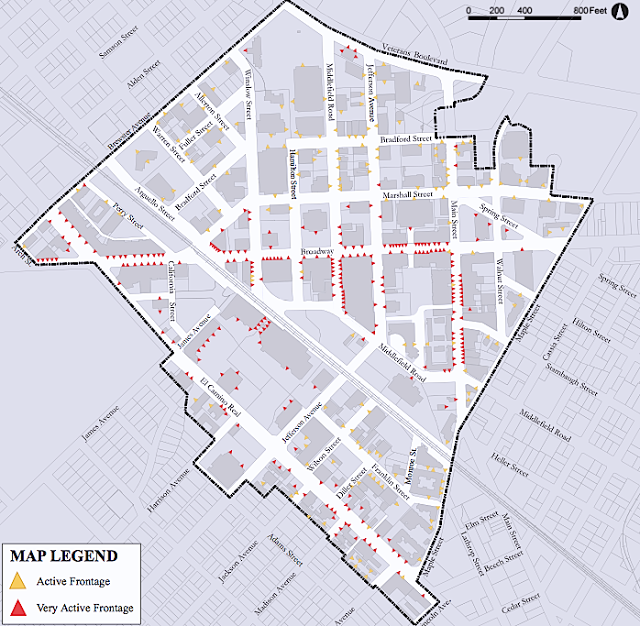
The yellow marks are residential and office entries, the red ones are retail+ uses. The blocks with tight clusters of entrances are the most fun and successful areas. The blocks with few or no entrances are shunned.
When a cool business comes along that wants to take up 300 feet along the main drag, it can be really difficult to say no. However, it is essential to work with them and get them wrapped with liner shops. The neighborhood, and the cool new business in question, will all be more successful in the long run if you can get this right.
A balanced approach to retail is critical to downtown and walkable neighborhood success. I hope this post and our experiences in Redwood City help to stimulate new thinking on the subject, and I look forward to continuing to learn from other cities who are making headway on creating vibrant urban retail and streetlife.
